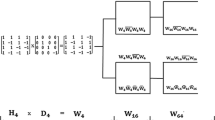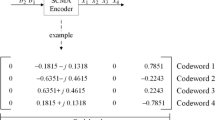Abstract
Nowadays, modern wireless mobile communication systems attempt to increase the number of subscribers simultaneously, starting from the third to fifth generations. The purpose of this research is to explain the correlation between the efficiency of the multi-user communication system and linear phase orthogonal binary codes (LPOBC) like Walsh and Gold codes. Query This work focuses on orthogonal binary sequences that are concurrent distributed over frequency and time domains according to the behavior of the correlation functions. Besides, the effect of using different code lengths with variable number of users will be examined and discussed. The communication system performance will be examined based on the cross-correlation and the autocorrelation behavior. This criterion is affected and influenced by the code length, bit error rate and signal to noise ratio. Furthermore, the impact of using the LPOBC on different modulation schemes is discussed. Finally, a case study utilizing code division multiple access is chosen as a practical case that has the potential of being further developed toward the fifth generation communication system.









Similar content being viewed by others
References
Manasreh, A., Sharadqh, A., Alkasassbeh, J., & Al-Qaisi, A. (2019). Ensuring telecommunication network security through cryptology: A case of 4G and 5G LTE cellular network providers. International Journal of Electrical and Computer Engineering. https://doi.org/10.11591/ijece.v9i6.pp4860-4865.
Huang, T., Yang, W., Wu, J., Ma, J., Zhang, X., & Zhang, D. (2019). A survey on green 6G network: Architecture and technologies. IEEE Access. https://doi.org/10.1109/ACCESS.2019.2957648.
Adachi, F., Garg, D., Takaoka, S., & Takeda, K. (2005). Broadband CDMA techniques. IEEE Wireless Communications. https://doi.org/10.1109/MWC.2005.1421924.
Moon, K. (2005). Error correction coding: Mathematical methods and algorithms. New Jersey: Wiley.
Hykin, S. (2005). Communication systems (4th ed.). New York: Wiley.
Poluri, R., & Kansu, A. (2007). Short length CDMA codes for wireless sensor networks. IEEE Sarnoff Symposium. https://doi.org/10.1109/SARNOF.2007.4567316.
Wang, X., Zhan, M., Gong, X., Lai, C., & Lai, Y. (2005). Spread-spectrum communication using binary spatiotemporal chaotic codes. Physics Letters A. https://doi.org/10.1016/j.physleta.2004.10.075.
Cevik, N., Cevik, T., & Gurhanl, A. (2019). Novel multispectral face descriptor using orthogonal walsh codes. IET Image Processing., 13(7), 1097–1104.
Walsh, J. (1923). "A closed set of normal orthogonal functions. American Journal of Mathematics. https://doi.org/10.2307/2387224.
Ghassemzadeh, S., Gerakoulis, D. (2000.) Extended orthogonal code designs with applications in CDMA. Proc. IEEE Sixth International Symposium on Spread Spectrum Techniques and Applications. New Jersey, USA. https://doi.org/10.1109/ISSSTA.2000.876515.
Usha, K., Sankar K. J. (2013). Performance analysis of new binary user codes for DS-CDMA communication over Rayleigh fading channel. Annual International Conference on Emerging Research Areas and 2013 International Conference on Microelectronics, Communications and Renewable Energy, Kanjirapally. https://doi.org/10.1109/AICERA-ICMiCR.2013.6576001.
Samundiswary, P., & Kalian, P. (2012). Performance analysis of WCDMA using different spreading codes. International Journal of Computer Applications. https://doi.org/10.5120/4642-6857.
Sikder, S., & Ghosh, S. (2018). Performance enhancement of optical code-division multiple-access systems using transposed modified Walsh code. Optical Engineering. https://doi.org/10.1117/1.OE.57.2.026114.
Sikder, S., Sarkar, M., & Ghosh, S. (2018). Optical network security using unipolar Walsh code. AIP Conference Proceedings. https://doi.org/10.1063/15032061.
Sarkar, M., & Ghosh, S. (2020). Development of a secured optical code-division multiple-access systems by implementing hybrid 2D-modified Walsh code. Optical Engineering. https://doi.org/10.1117/1.OE.59.10.106107.
Himeno, A., Kojima, T. (2020). An Improved AFC Scheme for Modified Walsh-Hadamard Code Division Multiplexing. 2020 International Conference on Advanced Technologies for Communications (ATC). https://doi.org/10.1109/ATC50776.2020.9255474.
Chen, P., Fang, Y., Su, K., & Chen, G. (2017). Design of a capacity-approaching chaos-based multiaccess transmission system. IEEE Transactions on Vehicular Technology. https://doi.org/10.1109/TVT.2017.2723608.
Raman Kumar, M., & Vaegae, N. K. (2020). Walsh code based numerical mapping method for the identification of protein coding regions in eukaryotes. Biomedical Signal Processing and Control. https://doi.org/10.1016/j.bspc.2020.101859.
Varku, S., et al. (2017). SPS gold code generation and implementation for IRNSS S. International Journal of Engineering Research and Application, 7(5), 48–53.
Kim, S. T., Ahn, J. M., (2019). Analysis of Correlation Characteristics of 10230 Period PRN Code using Concatenated Gold Code. 2019 International Conference on Electronics, Information, and Communication (ICEIC), https://doi.org/10.23919/ELINFOCOM.2019.8706491.
Jayapalan, A., Savarinathan, P., Priya, A. "SystemVue based Secure data transmission using Gold codes," 2019 International Conference on Vision Towards Emerging Trends in Communication and Networking (ViTECoN). https://doi.org/10.1109/ViTECoN.2019.8899471.
Liu, H. (2000). Signal processing applications in CDMA communications. Artech House: Massachusetts.
Saugstrup, D., & Henten, A. (2006). 3G Standards: The battle between WCDMA and CDMA2000. Info, 8(4), 10–20.
Alkasassbeh, J., Aws Al-Qaisi, M., & Al-Hunaity, J. A. (2016). Maximize saving transmitted power in wireless communication system using adaptive modulation technique. International Journal on Communications Antenna and Propagation., 6(2), 61–67.
Akansu, A., & Poluri, R. (2007). Walsh-like nonlinear phase orthogonal codes for direct sequence CDMA communications. IEEE Signal Processing Society, 55(7), 3800–3806.
Li, D. (2018). Overlapped multiplexing principle and an improved capacity on additive white gaussian noise channel. IEEE Access. https://doi.org/10.1109/ACCESS.2017.2787730.
Pursley, M. (1977). Performance evaluation for phase-coded spread-spectrum multiple-access communication-part I: System analysis. IEEE Transactions on Communications. https://doi.org/10.1109/TCOM.1977.1093915.
Muraoka, R., Covarrubias, D., Arvizu, A., & Mendieta, J. (2001). Design and implementation of a CDMA transmitter for mobile cellular communications. Journal of Applied Research and Technology, 1(2), 127–136.
Hong, E. K., Kim, K. J., & Whang, K. C. (1996). Performance evaluation of DS-CDMA system with M-ary orthogonal signaling. IEEE Transactions on Vehicular Technology. Doi, 10(1109/25), 481821.
Ashok Kumar, K., Dananjayan, P. (2018). Improvement of Code Utilization CDMA for On-Chip Communication Architecture using Orthogonal Gold Code. 2018 3rd International Conference on Inventive Computation Technologies (ICICT), Coimbatore, India. https://doi.org/10.1109/ICICT43934.2018.9034282.
O. B. Wojuola. ( 2018). Cross-correlation index and multiple-access performance of Gold codes in a spread-spectrum system. 20th International Conference on Advanced Communication Technology (ICACT), Chuncheon-si Gangwon-do, Korea (South). https://doi.org/10.23919/ICACT.2018.8323914.
Funding
None.
Author information
Authors and Affiliations
Corresponding author
Ethics declarations
Conflicts of interest
All authors declares that they have no conflict of interest.
Additional information
Publisher's Note
Springer Nature remains neutral with regard to jurisdictional claims in published maps and institutional affiliations.
Rights and permissions
About this article
Cite this article
Alkasassbeh, J., Al-Qaisi, A. & Khalifeh, A. BER Performance Using Linear Phase Orthogonal Binary Codes for Multi-users Mobile Communication. Wireless Pers Commun 119, 259–274 (2021). https://doi.org/10.1007/s11277-021-08206-8
Accepted:
Published:
Issue Date:
DOI: https://doi.org/10.1007/s11277-021-08206-8




